| Brassicales | |
|---|---|
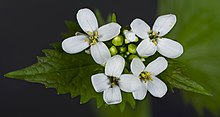
| |
| Alliaria petiolata, garlic mustard (Brassicaceae) | |
| Scientific classification | |
| Kingdom: | Plantae |
| Clade: | Tracheophytes |
| Clade: | Angiosperms |
| Clade: | Eudicots |
| Clade: | Rosids |
| Clade: | Malvids |
| Order: | Brassicales Bromhead |
| Families | |
The Brassicales (or Cruciales) are an order of flowering plants, belonging to the malvid group of eudicotyledons under the APG IV system. One character common to many members of the order is the production of glucosinolate (mustard oil) compounds. Most systems of classification have included this order, although sometimes under the name Capparales (the name chosen depending on which is thought to have priority).
The order typically contains the following families:
- Akaniaceae – two species of turnipwood trees, native to Asia and eastern Australia
- Bataceae – salt-tolerant shrubs from America and Australasia
- Brassicaceae – mustard and cabbage family; may include the Cleomaceae
- Capparaceae – caper family, sometimes included in Brassicaceae
- Caricaceae – papaya family
- Cleomaceae
- Gyrostemonaceae – several genera of small shrubs and trees endemic to temperate parts of Australia
- Koeberliniaceae – one species of thorn bush native to Mexico and the US Southwest
- Limnanthaceae – meadowfoam family
- Moringaceae – thirteen species of trees from Africa and India including the drumstick
- Pentadiplandraceae – African species whose berries have two highly sweet tasting proteins
- Resedaceae – mignonette family
- Salvadoraceae – three genera found from Africa to Java
- Setchellanthaceae
- Tiganophytaceae
- Tovariaceae
- Tropaeolaceae – nasturtium family
Classification
The following diagram shows the phylogeny of the Brassicales families along with their estimated ages, based on a 2018 study of plastid DNA:
| Brassicales families | |||||||||||||||||||||||||||||||||||||||||||||||||||||||||||||||||||||||||||||||||||||||||||||||||||
| |||||||||||||||||||||||||||||||||||||||||||||||||||||||||||||||||||||||||||||||||||||||||||||||||||
| Phylogentic relationships based on data from plastid DNA. The numbers next to each branching point indicate its estimated date (million years ago). Families with more than 30 species are in bold. |
On 20 April 2020, a newly described monotypic species from Namibia, namely, Tiganophyton karasense Swanepoel, F.Forest & A.E. van Wyk is placed under this order as a monotypic member of new family Tiganophytaceae, which is closely related to Bataceae, Salvadoraceae and Koeberliniaceae.
Historic classifications
Under the Cronquist system, the Brassicales were called the Capparales, and included among the "Dilleniidae". The only families included were the Brassicaceae and Capparaceae (treated as separate families), the Tovariaceae, Resedaceae, and Moringaceae. Other taxa now included here were placed in various other orders.
The families Capparaceae and Brassicaceae are closely related. One group, consisting of Cleome and related genera, was traditionally included in the Capparaceae but doing so results in a paraphyletic Capparaceae. Therefore, this group is generally now either included in the Brassicaceae or as its own family, Cleomaceae.
Gallery of type genera
For etymologies, see List of plant family names with etymologies.-
 Akania bidwillii (turnipwood family)
Akania bidwillii (turnipwood family)
-
 Batis maritima (turtleweed family)
Batis maritima (turtleweed family)
-
 Brassica oleracea (cabbage family)
Brassica oleracea (cabbage family)
-
 Capparis spinosa (caper family)
Capparis spinosa (caper family)
-
Carica papaya (papaya family)
-
 Cleome hassleriana (spiderflower family)
Cleome hassleriana (spiderflower family)
-
 Emblingia calceoliflora (slippercreeper family)
Emblingia calceoliflora (slippercreeper family)
-
 Gyrostemon ramulosis (buttoncreeper family)
Gyrostemon ramulosis (buttoncreeper family)
-
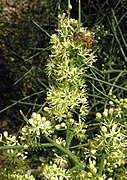 Koeberlinia spinosa (allthorn family)
Koeberlinia spinosa (allthorn family)
-
Limnanthes douglasii (meadowfoam family)
-
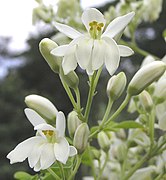 Moringa oleifera (horseradish-tree family)
Moringa oleifera (horseradish-tree family)
-
 Pentadiplandra brazzeana (oubli family)
Pentadiplandra brazzeana (oubli family)
-
Reseda lutea (mignonette family)
-
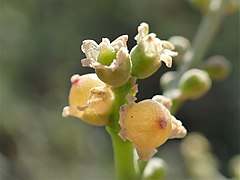 Salvadora persica (toothbrush-tree family)
Salvadora persica (toothbrush-tree family)
-
 Tovaria pendula (stinkbush family)
Tovaria pendula (stinkbush family)
-
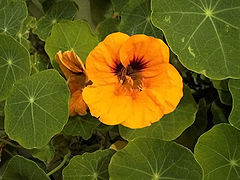 Tropaeolum majus (nasturtium family)
Tropaeolum majus (nasturtium family)
Setchellanthaceae is sometimes known as the azulita family.
References
- ^ Angiosperm Phylogeny Group (2009). "An update of the Angiosperm Phylogeny Group classification for the orders and families of flowering plants: APG III". Botanical Journal of the Linnean Society. 161 (2): 105–121. doi:10.1111/j.1095-8339.2009.00996.x. hdl:10654/18083.
- Angiosperm Phylogeny Group (2016). "An update of the Angiosperm Phylogeny Group classification for the orders and families of flowering plants: APG IV". Botanical Journal of the Linnean Society. 181 (1): 1–20. doi:10.1111/boj.12385.
- ^ Jocelyn C. Hall, Kenneth J. Sytsma & Hugh H. Iltis (2002). "Phylogeny of Capparaceae and Brassicaceae based on chloroplast sequence data". American Journal of Botany. 89 (11): 1826–1842. doi:10.3732/ajb.89.11.1826. PMID 21665611.
- ^ Elspeth Haston; James E. Richardson; Peter F. Stevens; Mark W. Chase; David J. Harris (2007). "A linear sequence of Angiosperm Phylogeny Group II families". Taxon. 56 (1): 7–12. doi:10.2307/25065731. JSTOR 25065731.
- Edger, Patrick P.; Hall, Jocelyn C.; Harkess, Alex; Tang, Michelle; Coombs, Jill; Mohammadin, Setareh; Schranz, M. Eric; Xiong, Zhiyong; Leebens-Mack, James; Meyers, Blake C.; Sytsma, Kenneth J.; Koch, Marcus A.; Al-Shehbaz, Ihsan A.; Pires, J. Chris (2018). "Brassicales phylogeny inferred from 72 plastid genes: A reanalysis of the phylogenetic localization of two paleopolyploid events and origin of novel chemical defenses". American Journal of Botany. 105 (3): 463–69. doi:10.1002/ajb2.1040. PMID 29574686.
- Swanepoel, Wessel; Chase, Mark W.; Christenhusz, Maarten J.M.; Maurin, Olivier; Forest, Félix; van Wyk, Abraham E. (2020). "From the frying pan: an unusual dwarf shrub from Namibia turns out to be a new brassicalean family". Phytotaxa. 439 (3): 171–185. doi:10.11646/phytotaxa.439.3.1.
- Jocelyn C. Hall, Hugh H. Iltis & Kenneth J. Sytsma (2004). "Molecular phylogenetics of core Brassicales, placement of orphan genera Emblingia, Forchhammeria, Tirania, and character evolution" (PDF). Systematic Botany. 29 (3): 654–669. doi:10.1600/0363644041744491. S2CID 86218316. Archived from the original (PDF) on 2011-04-01. Retrieved 2016-08-26.
- Christenhusz, Maarten; Fay, Michael Francis; Chase, Mark Wayne (2017). Plants of the World: An Illustrated Encyclopedia of Vascular Plants. Chicago, Illinois: Kew Publishing and The University of Chicago Press. pp. 401–419. ISBN 978-0-226-52292-0.
External links
 Media related to Brassicales at Wikimedia Commons
Media related to Brassicales at Wikimedia Commons
| Orders of flowering plants (APG IV) | ||||||||||||||||||||||||||||||||||||||||||||||||||
|---|---|---|---|---|---|---|---|---|---|---|---|---|---|---|---|---|---|---|---|---|---|---|---|---|---|---|---|---|---|---|---|---|---|---|---|---|---|---|---|---|---|---|---|---|---|---|---|---|---|---|
| Angiosperms |
|  | ||||||||||||||||||||||||||||||||||||||||||||||||